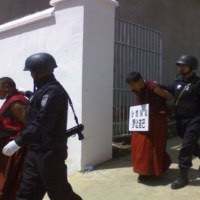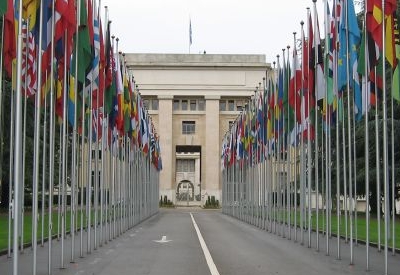Many challenges ahead for Tibetans in 2020
In 2020, the mantra remains the same for
Tibetans just as it has since October 7, 1950. That failed uprising in March 1959 against Chinese forces extinguished the hopes of a return to a way of life
that was nurtured over many centuries. Tibetan Buddhism was founded during the period of the "Religious Kings" during the reign of Songsten Gampo c 618 - c650.1 Today, democratisation continues to be a mythical ideal on the Tibetan
Plateau. Discrimination has remained steadfast since the occupation in 1950. Empowering Tibetan’s will require a visceral
approach to freedom by the international community in order to mitigate
against the harsh conditions that affect traditional Tibetans.
Approximately 156
people have self-immolated since February 27, 2009.) The issues affecting Tibetans include: degradation
of religious symbols, inability to express one’s adherence to Buddhism in
an overt manner (monks and nuns will continue to wear monastic robes), the cordoning
off of the Tibetan population by the incursion of Han Chinese for
purposes of labour, the continual “modernizing” of the delicate Tibetan landscape (see
the Qinghai-Tibet railway and the Sinicisation of the academic curriculae and workforce while the commodification of Mount Everest is a Nepali issue, too.)2 Deforestation and the disruption of the flow of rivers, as well
as other organic water systems are the consequences of building large dams to
produce hydroelectric power that incur permanent damage to the environment, not
to mention, nuclear waste. Indeed Tibet supplies 47% of the global population
with fresh water.
March 10, 1959 is the anniversary of the failed uprising led by the Dalai Lama, where Chinese officials totally restrict the movement around Tibet "security" reasons on an annual basis. Therefore, these restrictions continue to harden the diasporas and Tibetan citizenry impressions toward the central government.
Therefore, because of an aggressive infrastructure
program orchestrated by the central government to bolster growth throughout the
Tibetan Plateau, a quid pro quo is inevitable. On the one hand, this expansion will provide jobs for Han migrants
and, hopefully, assimilate Han and ethnic Tibetan’s into a closer relationship
with the central government, Tibetan culture, and, of course, to each other. Consequently, the opportunity cost to
the environment is beginning to mount.
According to Denise Thompson, a researcher
for Dharamsala based non-profit NGO – LHA Charitable Trust- “Tibet now has 14
percent more lakes than it did in 1970, and more than 80 percent of existing
lakes have expanded, flooding surrounding pastures and rural communities.
Ironically, because this flooding is uneven and unpredictable many pre-existing
lakes have dried up completely and several large wetland areas have become
deserts.”3
For Tibetan’s loyal to the Dalai Lama,
the situation remains difficult, as displaying a photo of His Holiness will
result in repercussions from Chinese authorities, who have labelled him a
separatist “wolf in sheep’s clothing.” There is an opportunity for Beijing to
reach out to Buddhist’s in general, and within its own borders to preserve this
historical way of life, while promoting religious freedom. Of course, Chinese
officials will have to accept Islam and those same officials will contend that Xinjiang
Province presents many difficulties with its Islamic adherents and notions of
separatism. The key difference between Xinjiang and Tibet is that Tibet was an
autonomous region up to the 1949 occupation. Chinese authorities perceive Xinjiang
and Tibet as unsophisticated in their infrastructure and ideology, and, most
importantly a part of China proper.
Xinjiang province has since 2017 been the site of large scale re-education camps affecting Muslim Uyghurs and, apparently, under the guise of being voluntary in nature. The International Consortium of Investigative Journalists collaborating with BBC Panorama discovered that "inmates are locked up, indoctrinated, and punished."
Data leak reveals how China 'brainwashes' Uighurs in prison camps
Protracted negotiations between the TGIE (Tibetan Government In Exile) and the CCP have little hope for a “power-sharing” arrangement at best, while a successor to the Dalai Lama seems muted as Beijing has made unstated claims that they will appoint their own Dalai Lama when the current one passes away. The concern should be very real as the original Panchen Lama(Gedhun Choekyi Nyima) has been missing since May 17,1995. Beijing appointed his successor (Gyaincain Norbu) on December 8, 1995.4
Xinjiang province has since 2017 been the site of large scale re-education camps affecting Muslim Uyghurs and, apparently, under the guise of being voluntary in nature. The International Consortium of Investigative Journalists collaborating with BBC Panorama discovered that "inmates are locked up, indoctrinated, and punished."
Data leak reveals how China 'brainwashes' Uighurs in prison camps
Protracted negotiations between the TGIE (Tibetan Government In Exile) and the CCP have little hope for a “power-sharing” arrangement at best, while a successor to the Dalai Lama seems muted as Beijing has made unstated claims that they will appoint their own Dalai Lama when the current one passes away. The concern should be very real as the original Panchen Lama(Gedhun Choekyi Nyima) has been missing since May 17,1995. Beijing appointed his successor (Gyaincain Norbu) on December 8, 1995.4
The Dalai Lama acknowledged in a
December 16, 2014 BBC article that China’s exuberance to modernize may well
mean the demise of the position of Dalai Lama, that has existed since 1391; at
least, the notable incarnations of Dalai Lama’s. His Holiness explained to the
BBC “”There is no guarantee that some stupid Dalai Lama won’t come next, who
will disgrace himself or herself. That would be very sad. So, much better that
a centuries-old tradition should cease at the time of a quite popular Dalai
Lama.”5
It is very difficult for Sikyong Lobsang
Sangay to garner any credibility as Head of the Tibetan Government in Exile when the
International Community deems Tibet part of China, and are enthralled with inexpensive
Chinese goods to grow their economy. As China’s economy stagnates slightly along with the devastating effects of the coronavirus, Chinese officials can be reminded of the Swiss currency that is being devalued starting in January
2015; a devalued renminbi might pave the way for Tibetans to become more active managing the government apparatus.
This could be the penultimate quid pro quo , or, at least an obvious sign of
democratic reform leading to a more prosperous and spiritual future. Robert Barnett,
a professor of modern Tibetan studies at Columbia University stated ““The people pushing these policies can’t
really see the ‘smaller’ issues of preserving culture and the environment, it
is like using a bulldozer to herd mice.”
How can we help Tibetans? Of course, making
a donation will help, though, being careful as a consumer can be an effective device
if we minimise our purchase of Chinese made products and write our Head of
State or Department of Foreign Affairs.6
International Contacts
Algeria -- Abdelmadjid Tebboune -- President@el-mouradia.dz
Australia: https://www.pm.gov.au/contact-your-pm
Brazil: https://sistema.planalto.gov.br/falepr2/index.php?IND_IDIOMA=I
Canada: https://pm.gc.ca/en/connect/contact
China: Pres. Xi Jinping xi.jinpeng@china.gov.cn/10 6307 0900 - FAX/ 10 6307 0913 - PHONE
Ecuador: President Lenin Moreno webmast@mmrree.gov.ec
Finland: Prime Ministers Office kirjaamo@vnk.fi
International Contacts
Algeria -- Abdelmadjid Tebboune -- President@el-mouradia.dz
Australia: https://www.pm.gov.au/contact-your-pm
Brazil: https://sistema.planalto.gov.br/falepr2/index.php?IND_IDIOMA=I
Canada: https://pm.gc.ca/en/connect/contact
China: Pres. Xi Jinping xi.jinpeng@china.gov.cn/10 6307 0900 - FAX/ 10 6307 0913 - PHONE
Ecuador: President Lenin Moreno webmast@mmrree.gov.ec
Finland: Prime Ministers Office kirjaamo@vnk.fi
France: https://www.elysee.fr/ecrire-au-president-de-la-republique/
Germany: Chancellor Merkel -- https://www.bundeskanzlerin.de/bkin-en/service/contact/contact
Greenland: Mr. Kim Kielsen (Siumut) govsec@nanoq.gl
Great Britain: boris.johnson.mp@parliament.uk
India: https://pmopg.gov.in/pmocitizen/Grievancepmo.aspx
Israel: Prime Minister Benjamin Netanyahu
https://forms.gov.il/globaldata/getsequence/getHtmlForm.aspx?formType=ContactUsEn@pmo.gov.il
Italy: presidente@pec.governo.it
Japan: https://www.kantei.go.jp/foreign/forms/comment_ssl.html
Mexico: comunicacion.digital@presidencia.gob.mx
Russia: President Putin -- http://en.letters.kremlin.ru/letters/send
Saudi Arabia: https://mci.gov.sa/en/contactus/Pages/default.aspx
South Africa: Pres. Cyril Ramaphosa --
khusela@presidency.gov.za
http://www.thepresidency.gov.za/content/contact-us
Sweden: Prime Minister: Stefan. Lofren. statsradsberedningen.registrator@gov.se
Taiwan: President Tsai -- https://service.president.gov.tw/newmailboxen/write.aspx
Sweden: Prime Minister: Stefan. Lofren. statsradsberedningen.registrator@gov.se
Taiwan: President Tsai -- https://service.president.gov.tw/newmailboxen/write.aspx
United States: https://www.whitehouse.gov/contact/
For a comprehensive list, follow this link: Global Leaders email addresses
Works Cited
1Kieswetter, Kevin. "Chariot's of Fire: A Tibetan Historical Perspective." CreateSpace. Charleston: 2014.
2 ”Tibet:Taming the west, The Communist Party deepens Tibet’s integration with the
2 ”Tibet:Taming the west, The Communist Party deepens Tibet’s integration with the
rest of the country.”The Economist. 21 June,
2014. <https://www.economist.com/china/2014/06/21/taming-the-west>. 18 December 2014.
3Thompson, Denise. “Global Warming –Tibet’s
problems are the World’s problems
too.” Tibet Nature Conservation Network.18
November 2014.
<http://www.tibetnature.net/en/global-warming-tibets-problems-worlds-problems/>.
18 December 2014.
18 December 2014.
4Huang, Zheping. "The spiritual leader China appointed for Tibetan Buddhism urged monks to love the Communist Party." Quartz. 14 March 2017. <https://qz.com/931671/the-spiritual-leader-china-appointed-for-tibetan-buddhism-urged-monks-to-love-the-communist-party/>. 16 January 2020.
5”Dalai Lama concedes he may be the last.”
BBC News China. 16 December 2014. <http://www.bbc.com/news/world-asiachina-30510018>. 18 December 2014.
6"Tibet's History & Culture." Free Tibet. <https://freetibet.org/about/history-religion-culture>. 16 January 2020.
6"Tibet's History & Culture." Free Tibet. <https://freetibet.org/about/history-religion-culture>. 16 January 2020.
 |




